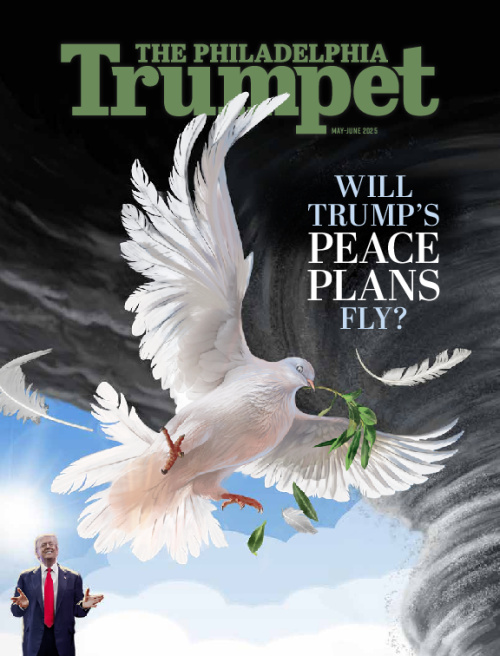Eliminating the Need for the Dollar

Eliminating the Need for the Dollar
The horizon is darkening for the world’s dominant currency. Despite some positive financial news in the United States, other nations continue to reduce their reliance on the U.S. dollar. The price of gold has spiked past $3,000 per ounce as central banks around the world load up on the precious metal in lieu of dollars.
Yet the U.S. dollar may soon face an even more formidable rival than gold bullion: digital money.
The only reason the dollar has not collapsed already is that the world’s other major currencies are in even worse shape. Since there is currently no viable alternative reserve currency, central banks grudgingly work past the dollar’s flaws and continue to use it for international transactions. But what would happen if those banks no longer needed currency reserves at all?
Soon after China launched a digital yuan in 2021, the Bank for International Settlements launched a technology called Multiple Central Bank Digital Currency Bridge (mBridge). This project is designed to tie together central bank digital currencies from China, Hong Kong, Saudi Arabia, Thailand and the United Arab Emirates. Once operational, these five nations will not need to use dollars in cross-border payments as the mBridge system converts digital yuan to digital riyal, and digital baht into digital dirham.
The goal of mBridge is to eliminate the need for nations to keep U.S. dollars in reserve to make international transactions. This will drastically reduce demand for the dollar and tank its value. That will destabilize the U.S. economy, exacerbating the nation’s debt and making the U.S. vulnerable in almost every imaginable sense—abroad and at home.
The Bank for International Settlements is not attempting to achieve this goal by replacing the dollar with a new reserve currency: It aims to accomplish it by eliminating the need for a reserve currency altogether. This would be a major problem for the U.S., which needs other nations to keep buying U.S. treasury bonds so it can pay the interest on its $36 trillion national debt.
Embracing Digital Money
To preserve the dollar as the world reserve currency, Joe Biden and his regime announced plans to design its own central bank digital currency, dubbed the “digital dollar” or “FedCoin.”
FedCoin would allow the U.S. to participate in its own mBridge-style system. It would also mean dark days for freedom. Unlike private cryptocurrencies that operate in decentralized systems, central bank digital currencies are issued, backed and controlled by central banks. They give central banks—and the governments that support them—the power to monitor every digital monetary transaction.

The regime in China already uses digital yuan as a mass surveillance tool, and FedCoin would give the U.S. government the same power. This is why the Make America Great Again movement staunchly opposes FedCoin and all other central bank digital currencies. But constitutional conservatives don’t want the dollar to lose its reserve currency status either, at least not until America has paid down enough of its debt that it does not need to constantly sell Treasury bonds to survive. The dollar must remain competitive in a digital world.
Caught between a rock and a hard place, Donald Trump took action quickly once he took office. On January 23, the president signed an executive order titled “Strengthening American Leadership in Digital Financial Technology.” It bars federal agencies from developing a central bank digital currency while promoting the development of dollar-backed stablecoins worldwide. Its intention is to prevent an Orwellian surveillance state from hijacking America while simultaneously allowing the dollar to be used in digital blockchain networks in international transactions.
A stablecoin is a cryptocurrency where the value of the digital asset always matches another currency or asset. Stablecoins like Circle or Tether are redeemable 1:1 for U.S. dollars, so people can use these cryptocurrencies to participate in a blockchain network and cash out for dollars whenever needed.
Tech entrepreneur Elon Musk uses stablecoins to send money internationally because it’s instantaneous and cheaper than traditional banking and avoids the privacy concerns associated with central bank digital currencies. Trump supports stablecoins for the same reason. He holds a leadership position at World Liberty Financial, a crypto venture that recently launched a U.S. dollar-pegged stablecoin “inspired by President Donald J. Trump.”
Only time will tell how President Trump’s strategy will play out. So far, its main effect has been to prompt the European Central Bank (ecb) to fast-track the development of a digital euro. On January 24, ecb board member Piero Cipollone warned that stablecoins could threaten European banks. He wants the eurozone to launch its own central bank digital currency.
Currency War
Almost a decade ago, former German Minister of Economics and Technology Karl-Theodor zu Guttenberg warned that Europe was sleeping through the currency digitization revolution.
“I am convinced that blockchain will evolve and become very important,” he told an audience in Switzerland in 2016. “The technology could speed up transactions and save banks money—the middle man would become obsolete. … I hope that Europe will come to its senses, build a strong blockchain hub, and not leave this development to the other side of the Atlantic.”
Few people acted on the trend Guttenberg was pointing out until President Trump took action to develop a U.S. dollar-pegged stablecoin. Now ecb chief economist Philip Lane says that a digital euro is essential to safeguarding Europe’s financial system. “The digital euro is not just about modernizing our monetary system,” he said. “It’s about securing Europe’s financial independence in an era of increasing geopolitical fragmentation. … If dollar stablecoins gain traction in domestic transactions, they could indirectly anchor Europe’s payment system to the U.S. currency ….”
In other words, if the euro does not digitize, European companies will continue to rely on the giant U.S. payment corporations like Visa, Mastercard, PayPal, Apple and Google. That would be good news for the dollar’s status as the reserve currency, but it would keep Europe reliant on the United States.

In the age of Trump, many European leaders want independence from the U.S. Thus, developing a digital euro that can be traded via a blockchain has shot up the priority list.
The cryptocurrency world is now dividing into two giant currency blocs: a U.S.-led bloc promoting stablecoins and a Euro-Asian block promoting central bank digital currencies.
President Trump is fighting back against the central bank digital currency network China has been developing for the past four years, yet Bible prophecy indicates America will not do well against the economies allied against it. This is not because President Trump’s stablecoin idea is inferior to the digital yuan or digital euro. Rather it is because God prophesied that a “mart of nations” would rise and be used to punish the American people for their sins.
The world is turning against America, and technologies like mBridge may make it easier for America’s economic rivals to collude with each other without having to give up their own currencies.
‘Mart of Nations’
If Europe and Asia acted together, they could dethrone the dollar and revolutionize global finance to an extent not seen since the Chinese introduced paper money to the world. Amazingly, the Bible prophesied of an end-time economic alliance against America and Britain thousands of years ago.
In Isaiah’s End-Time Vision, Trumpet editor in chief Gerald Flurry explains the Bible’s prophecies that the world economy will be dominated by three power blocs in the end time: Tyre, Tarshish and Kittim. Tyre, he explains, represents the commercial center of the modern-day European Union; Tarshish is modern-day Japan; Kittim is modern-day China. Isaiah 23:1-3 say that the merchants of Tarshish will mourn when Tyre is overthrown. This shows that Japan and China will be in a close economic partnership with a German-led superstate that dominates international trade.
Other Bible prophecies such as Leviticus 26 and Deuteronomy 28 show that the modern-day nations of Israel (the United States and Britain primarily) will be besieged until they are destroyed. This indicates that the Isaiah 23 mart of nations is an anti-American alliance. Such an alliance would have no interest trading in dollars. This means the process of international trade with the dollar will have been replaced. A blockchain network allowing digital yuan, digital yen and digital euros to be electronically traded could be the deciding factor.
Prophecies about the mart of nations are not limited to the Old Testament. Revelation 17 reveals that a powerful religious entity will become a guiding force over a great economic powerhouse that dazzles all nations with its wealth and splendor. Revelation 18:3 says that “the merchants of the earth have become rich through the abundance of her luxury” (New King James Version). Revelation 13:17 shows that people will be unable to buy or sell if they do not obey this religious entity. This sobering prophecy may require blockchain-like technology to fully implement.
These verses are about a European financial power, but these merchants are not only active in Europe—they are doing business in nations all around the world. China and Japan will ally with a revived Holy Roman Empire to replace the current Anglo-American economic system.
Herbert W. Armstrong wrote in 1984 that a banking crisis in America “could suddenly result in triggering European nations to unite as a new world power, larger than either the Soviet Union or the U.S.” (co-worker letter, July 22, 1984). This unification of core European nations could also be accompanied by a new digital currency.
As the 2008 financial crisis showed, a banking crisis could easily cause the dollar to collapse. America’s enemies are aware of this fact and may even try to purposely provoke such a crisis. Though digital currencies and blockchain network are cutting-edge technologies, the economic trends unfolding today were prophesied in your Bible long before the first coins were minted!
